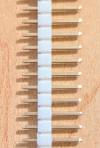This is an old revision of the document!
Assembling the Device
The LVR and LVR Custom PCBs are very easy to assemble together. All you need is a 40-pin socket for the CPU, a 14-pin socket if you need the inverter to be installed, the DS1233 device and two 20-pin strips for the device connection to the board's CPU socket. The 40-pin socket should be a ladder-type socket, preferably with only one “rung” in the middle of the socket, so that it does not interfere with the placement of the DS1233 device.
First, you will position the socket that the CPU will plug into. Place the 40=pin socket on the parts side of the board using the pins that are closest to the top of the board (the ones numbered 40-21), and the ones furthest from the bottom of the board. Bend the corner legs a bit so that the socket remains in position when you turn the PCB over to expose the solder side. This will serve as a guide so that you know which holes to solder the strip pins into, which will plug into the existing CPU socket on the board.
Now, before you solder those pins, you have to carefully select the pins you are going to use. If you use standard header-type pins which are commonly used with shorting blocks and look like this:
…those pins are quite a bit larger than standard IC legs and once you insert them into the socket on the board, you will permanently bend the fingers in that socket and that socket will no longer be useful if you remove the device. You should use the thinner strip pins, which are harder to find and are a little more expensive, which look like this:
Since their pins are smaller, they are less likely to damage the socket. Once you have decided on your pins, insert them from the solder side of the board, solder the pin strips into to the bottom of the board. In retrospect, I should have placed markings on the solder side to clearly indicate the holes to use. It will be easier to align the strips if you place them into another 40-pin socket and then insert them into the PCB. That will help ensure they are aligned properly, especially of you have multiple pieces instead of two contiguous 20-pin strips. Remove the socket from the parts side of the PCB and solder the pins in place on the parts side of the board and remove the socket that was aligning the pins (if used).
Now, you will replace place and solder the 40-pin socket. Once it is soldered in, place and solder the DS1233 device. If you use the thru-hole version, leave enough of the leads above the board so that you can bend the device down at a just about a right angle so it fits in the void space in the socket.
If you have determined you need the inverter, solder its socket and place it into the socket.
You can now configure the device, as detailed on the Configure page.


